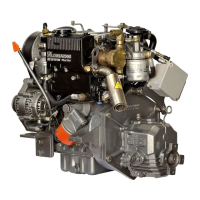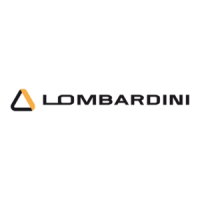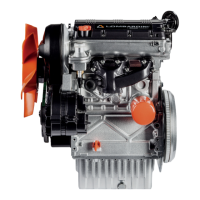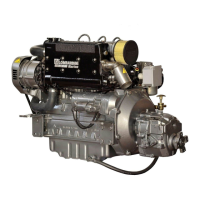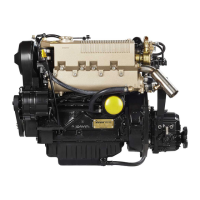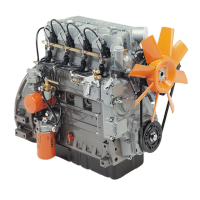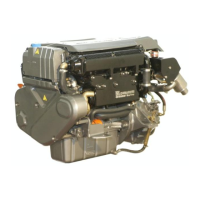- 11 -
FOCS Workshop Manual_cod. 1.5302.351_7° ed_ rev. 06
1
• During operation, the surface of the engine can become dangerously hot.
Avoid touching the exhaust system in particular.
• Before proceeding with any operation on the engine, stop it and allow it to cool.
Never carry out any operation whilst the engine is running.
• The coolant fluid circuit is under pressure.
Never carry out any inspections until the engine has cooled and even in this case, only open the radiator plug or
expansion chamber with the utmost caution, wearing protective garments and goggles. If there is an electric fan, do not
approach the engine whilst it is still hot as the fan could also start operating when the engine is at a standstill.
Only clean the coolant system when the engine is at a standstill.
• When cleaning the oil-cooled air filter, make sure that the old oil is disposed of in the correct way in order to safeguard
the environment.
The spongy filtering material in oil-cooled air filters must not be soaked in oil.
The reservoir of the separator pre-filter must not be filled with oil.
• The oil must be drained whilst the engine is hot (oil T ~ 80°C).
Particular care is required to prevent burns.
Do not allow the oil to come into contact with the skin.
• Pay attention to the temperature of the oil filter when the filter itself is replaced.
• Only check, top up and change the coolant fluid when the engine is off and cold.
Take care to prevent fluids containing nitrites from being mixed with others that do not contain these substances since
"Nitrosamine", dangerous for the health, can form.
The coolant fluid is polluting and must therefore be disposed of in the correct way to safeguard the environment.
• During operations that involve access to moving parts of the engine and/or removal of rotating guards, disconnect and
insulate the positive wire of the battery to prevent accidental short-circuits and to stop the starter motor from being
energized.
• Only check belt tension when the engine is off.
• Only use the eyebolts installed by LOMBARDINI to move the engine.
These lifting points are not suitable for the entire machine; in this case, the eyebolts installed by the manufacturer should
be used.
General remarks and safety information
GENERAL SAFETY DURING OPERATING PHASES
–The procedures contained in this manual have been tested and selected by the manufacturer’s technical experts, and hence
are to be recognised as authorised operating methods.
–A number of procedures must be carried out with the aid of equipment and tools that simplify and improve the timing of
operations.
–All tools must be in good working condition so that engine components are not damaged and that operations are carried out
properly and safely.
It is important to wear the personal safety devices prescribed by work safety laws and also by the standards of this manual.
–Holes must be lined up methodically and with the aid of suitable equipment. Do not use your fingers to carry out this operation
to avoid the risk of amputation.
–Some phases may require the assistance of more than one operator. If so, it is important to inform and train them regarding
the type of activity they will be performing in order to prevent risks to the health and safety of all persons involved.
–Do not use flammable liquids (petrol, diesel, etc.) to degrease or wash components. Use special products.
–Use the oils and greases recommended by the manufacturer.
Do not mix different brands or combine oils with different characteristics.
–Discontinue use of the engine if any irregularities arise, particularly in the case of unusual vibrations.
–Do not tamper with any devices to alter the level of performance guaranteed by the manufacturer.
SAFETY AND ENVIRONMENTAL IMPACT
Every organisation has a duty to implement procedures to
identify, assess and monitor the influence of its own activities
(products, services, etc.) on the environment.
Procedures for identifying the extent of the impact on the
environment must consider the following factors:
- Liquid waste
- Waste management
- Soil contamination
- Atmospheric emissions
- Use of raw materials and natural resources
- Regulations and directives regarding environmental impact
In order to minimise the impact on the environment, the
manufacturer now provides a number of indications to be
followed by all persons handling the engine, for any reason,
during its expected lifetime.
- All packaging components must be disposed of in accordance
with the laws of the country in which disposal is taking place.
- Keep the fuel and engine control systems and the exhaust
pipes in efficient working order to limit environmental and
noise pollution.
- When discontinuing use of the engine, select all components
according to their chemical characteristics and dispose of
them separately.
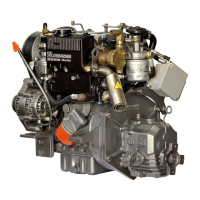
